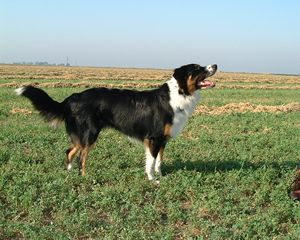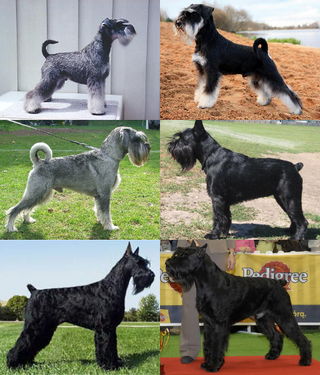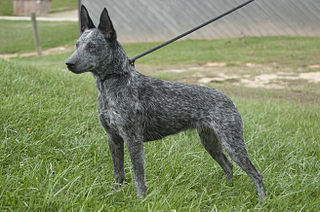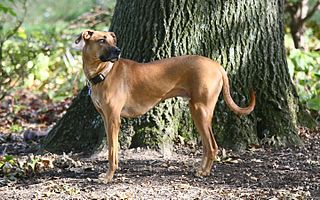
The Australian Kelpie, or simply Kelpie, is an Australian sheepdog capable of mustering and droving with little or no guidance. It is a medium-sized dog and comes in a variety of colours. The Kelpie has been exported throughout the world and is used to muster livestock, primarily sheep, cattle and goats.

The English Shepherd is a breed of herding dog from the United States.

The Australian Cattle Dog, or simply Cattle Dog, is a breed of herding dog developed in Australia for droving cattle over long distances across rough terrain. This breed is a medium-sized, short-coated dog that occurs in two main colour forms. It has either red or black hair distributed fairly evenly through a white coat, which gives the appearance of a "red" or "blue" dog.

A working dog is a dog used to perform practical tasks, as opposed to pet or companion dogs.

A herding dog, also known as a stock dog or working dog, is a type of dog that either has been trained in herding livestock or belongs to one of the breeds that were developed for herding. A dog specifically trained to herd sheep is known as a sheep dog or shepherd dog.

Collies form a distinctive type of herding dogs, including many related landraces and standardized breeds. The type originated in Scotland and Northern England. Collies are medium-sized, fairly lightly-built dogs, with pointed snouts. Many types have a distinctive white color over the shoulders. Collies are very active and agile, and most types of collies have a very strong herding instinct. Collie breeds have spread through many parts of the world, and have diversified into many varieties, sometimes mixed with other dog types.

A Schnauzer is a dog breed type that originated in Germany from the 14th to 16th centuries. The term comes from the German word for "snout" and means colloquially "moustache", or "whiskered snout", because of the dog's distinctively bearded snout. Initially it was called Wire-Haired Pinscher, while Schnauzer was adopted in 1879.

A guard dog or watchdog is a dog used to watch for and guard people or property against unwanted or unexpected human or animal intruders.

The Lancashire Heeler is a small breed of dog developed for use as a drover and herder of cattle. The Lancashire Heeler is listed by the Kennel Club (UK) as an endangered breed. The breed was recognized by the American Kennel Club in 2024.
A natural bobtail is an animal's tail which due to a mutated gene grows unusually short or is missing completely. The genes for the shortened tail may be dominant or recessive.

The Australian Stumpy Tail Cattle Dog, commonly known as the Stumpy, is a naturally bobtailed or tailless medium-sized cattle dog closely related to the Australian Cattle Dog. The Australian Stumpy Tail Cattle Dog and the Australian Cattle Dog share Halls Heeler origin.

A feist is a small hunting dog. This group descended from the terriers brought over to the United States by British miners and other immigrants. These terriers probably included crosses between the Smooth Fox Terrier, the Manchester Terrier, and the now-extinct English White Terrier. These dogs were used as ratters, and gambling on their prowess in killing rats was a favorite hobby of their owners. Some of these dogs have been crossed with Greyhounds, Whippets or Italian Greyhounds, and Beagles or other hounds — extending the family to include a larger variety of purpose than the original ratter, or Rat Terrier.

The Black Mouth Cur, also known as the Southern Cur, Southern Black Mouth Cur and the Yellow Black Mouth Cur, is a medium to large sized breed of cur-type dog from the United States. Originating in the south of the country, the breed is a popular hunting companion used to hunt a large variety of game.

The Welsh Sheepdog is a breed of herding dog of medium size from Wales.

Dog types are broad categories of domestic dogs based on form, function, or style of work, lineage, or appearance. Some may be locally adapted dog types that may have the visual characteristics of a modern purebred dog. In contrast, modern dog breeds strictly adhere to long-established breed standards,[note 1] that began with documented foundation breeding stock sharing a common set of inheritable characteristics, developed by long-established, reputable kennel clubs that recognize the dog as a purebred.

The Smithfield, Smithfield Collie or Smithfield Sheepdog is a breed of herding dog. It is a large, strong dog of the collie type. The Smithfield can be black, grey or red with a white collar, or wholly white and they always possess floppy ears and shaggy hair on the body, face and legs. Two varieties exist, with one having a natural bobtail and the second with a longer tail. It was used for droving cattle in the southeast of England, especially the Smithfield Market in London, and although this breed of dog is believed to be extinct and was never recognised by any of the major kennel clubs before its extinction, dogs of a similar type are shown under the same name in Tasmania, Australia.

The Halls Heeler is the presumed ancestor of two present-day dog breeds, the Australian cattle dog and the Australian stumpy tail cattle dog.
The Welsh Grey or Old Welsh Grey was a breed of sheepdog native to Wales. It is probably now extinct.
The Welsh Hillman was an ancient landrace or type of herding dog in Wales, used for herding and droving. The variety is thought to have become extinct around 1990.


















